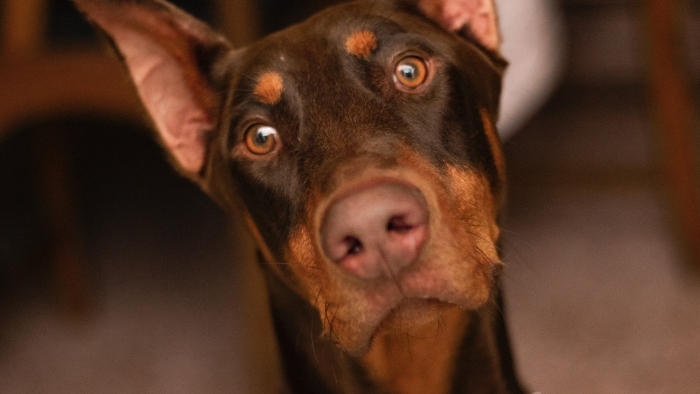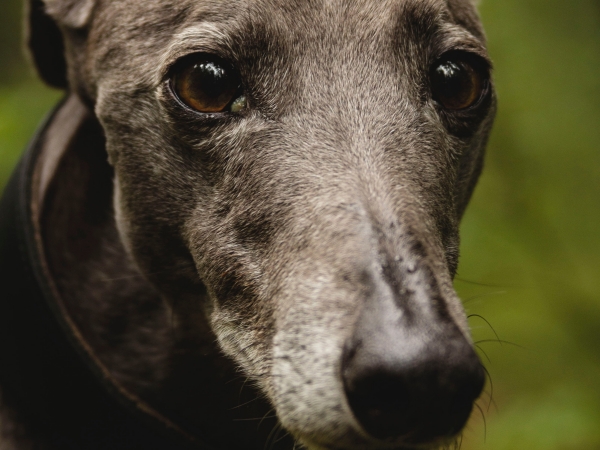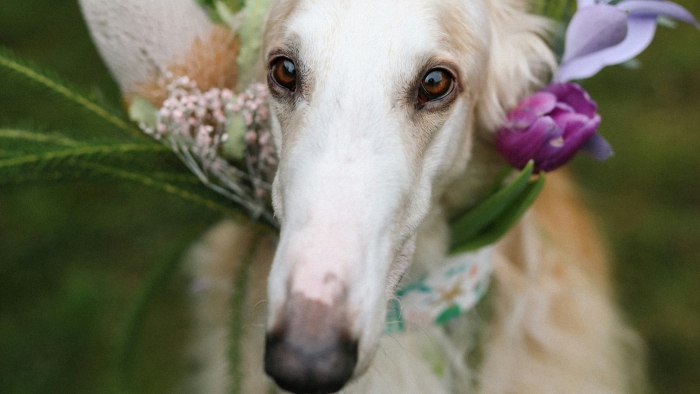Long Neck Dog:10 Breeds You Need To Know

Does the long neck dog breed hold a special allure that garners widespread admiration?
Indeed, it does! The elongated necks of these breeds are often perceived as more graceful than their counterparts, and numerous dog enthusiasts believe they exhibit a more regal demeanor.
Furthermore, the long neck dog is frequently thought to possess greater intelligence compared to other breeds.
Regardless of one’s stance on whether a long neck signifies a dog’s sophisticated look and clever nature, it’s undeniable that these dogs are both charming and distinctive.
Below, we explore 10 dog breeds renowned for their long necks.
Doberman Pinscher
The Doberman Pinscher is a sizable breed, distinguished by its elongated head and robust physique. These dogs generally exhibit a friendly demeanor towards people, yet they may display aggression if not adequately socialized and trained.

They show loyalty to their owners and can be affectionate with children, especially when brought up alongside them. However, it’s not uncommon for some Dobermans to form a deep bond with a single person.
For those aspiring to be responsible Doberman owners, it’s crucial to invest the necessary time and effort in nurturing a well-behaved, intelligent, and obedient Doberman Pinscher.
The intelligence of this breed should never be underestimated. Ranked among the most intelligent dogs, Dobermans often require owners who can match their cleverness to avoid being outwitted by their pets.
Furthermore, the Doberman Pinscher was originally bred for guard duty. Their intelligence enables them to anticipate potential threats, and they possess the strength to defend against any danger.
However, their sharp intellect can sometimes lead them to be excessively wary of strangers, potentially resulting in aggressive behaviors towards unfamiliar visitors.
Most Doberman owners do not actually need a trained guard dog; rather, they seek a friendly, intelligent, loyal, and protective companion. A well-bred Doberman, raised by its owner from puppyhood, will naturally develop protective instincts towards its family, making it an efficient guardian.
Chinese Crested
The Chinese Crested, a beloved hairless variety, stands out as one of the most amiable long-necked dog breeds. Their affinity for human companionship is matched only by their desire for reciprocal affection.
In terms of physique, the Chinese Crested dog exhibits a rectangular shape, where the body length modestly exceeds its height. This structural design affords the dog a comfortable range of motion. The breed’s slender, elegant build is further accentuated by its elongated neck.
Despite their small stature, these dogs possess vibrant personalities that are more than makeup for their size. They are full of joy and vigor, and they interact well with children.
Their high intelligence makes them relatively straightforward to train. These sensitive canines thrive on ample attention and care from their owners.
However, there’s a risk of developing small-dog syndrome if they are overindulged or given too much liberty.
Greyhound
Greyhounds are primarily bred for racing rather than hunting. These dogs are known for their streamlined, quick, and elegant forms, featuring muscular builds, slender heads, and notably long heads and necks.

The disposition of a Greyhound is typically gentle and affable. They are often great with children and get along with other animals, though they may not fare as well with smaller pets.
Greyhounds, when not lounging on the couch, enjoy indulging in long walks and occasionally chasing squirrels that unexpectedly cross their path.
Despite their reputation for being highly active, Greyhounds are actually quite content with daily naps. They adapt well to living in apartments or houses with smaller yards due to their minimal indoor activity requirements.
Whippet
The Whippet, bearing a resemblance to its Greyhound relative in size and form, differs slightly in cranial structure. Its face is more elongated and narrower compared to the Greyhound’s, featuring a shorter muzzle and broader nostrils. The Whippet’s oval eyes impart a look of intelligence.
Upon initial observation, the Whippet seems to be an ideal companion – hospitable towards guests and unfamiliar faces, not prone to boredom, sufficiently compact for home living, and not overly vocal.
Essentially, while it may alert you to someone at the door, it doesn’t quite fit the mold of a traditional guard dog. Whippets tend to thrive in a group rather than as solo pets, forming deep bonds with their families and enjoying the company of children and other animals.
Training a Whippet is generally straightforward, though they are not particularly fond of outings in rain or snow (yet they do delight in water play).
While a Whippet puppy is often characterized as gentle, this trait does not extend to its behavior towards cats or other small, furry creatures.
For those owning rabbits or hamsters, it is advisable to maintain a distance between these pets and a Whippet, as they might be seen as potential prey.
Basenji
The Basenji, a compact, nimble, and vivacious hunter originating from Congo, exhibits keen, upright ears, almond-shaped eyes in dark hazel or brown, and a bushy tail that curls onto its back. The furrows on their brow lend them a charmingly worried expression.
As an astute breed, the Basenji requires ample physical exercise and intellectual stimulation daily. They are known for their strong-willed, clever, and impish nature.
While they may bark at unfamiliar guests, they are not typically intimidating and may even greet amicable visitors warmly. However, they are quick to sound an alarm with a loud bark upon detecting anything suspicious.
Basenjis have a knack for training their owners to tidy up, as any item left within their sight is prone to being gnawed or consumed. Owners soon learn to safeguard their belongings by keeping them out of the Basenji’s reach.
On a positive note, Basenjis are playful and exhibit grooming habits that are almost akin to those of cats.
Afghan Hound
The Afghan Hound boasts a formidable physique with its lengthy neck, broad hips, deep chest, large feet, straight spine, and a long, sleek tail, all contributing to its majestic appearance.
Its most striking characteristic is undoubtedly its coat – long, silky, and flowing, reminiscent of the flamboyant hairstyles of ’70s rock or pop icons.
Originally bred for hunting large prey in the arid and mountainous terrains of Afghanistan, this breed is valued for its agility, stamina, and autonomous nature.
Hunters particularly appreciate the Afghan Hound for its independent demeanor and ability to confront and detain dangerous game until it can be secured.
Despite being known for requiring considerable upkeep due to its intelligent and sensitive nature, especially when it comes to training methods, the Afghan Hound is, in fact, quite intelligent and receptive to training.
Borzoi
Continuing with our compilation of long-necked dog breeds, the Borzoi comes next, bearing a resemblance to the Greyhound in its appearance.

While they may not rank as the most intelligent of breeds, their affability is undeniable. Borzois are not inclined towards rough play with children, preferring to maintain a certain level of dignity. Nevertheless, they show profound affection towards their family and friends.
A minimum of one hour of physical activity each day, preferably in the form of extended walks, is essential for them. It’s crucial to keep them leashed during walks, as the allure of tracking wildlife like cats or squirrels in the wilderness is irresistible to them.
This breed also enjoys engaging in outdoor activities with their owner and often excels in dog sports such as lure coursing and obedience.
Borzois can adapt to apartment living provided they receive adequate exercise. They tend to be relatively inactive and quiet indoors, thus not drawing much attention.
However, they thrive with ample space outdoors for roaming and playing, making a home with at least a moderately-sized backyard ideal for them.
Pharaoh Hound
The Pharaoh Hound, an ancient breed hailing from Egypt, features prominent pointed ears, a sleek, short coat, and a lithe, elongated physique. Among its endearing characteristics is its unique ability to blush, displaying a noticeable red hue on its face and neck when excited, happy, or engaged in playful activities.
It’s common for owners to teach their Pharaoh Hound to smile. Given this breed’s innate fondness for smiling, training them in this behavior is usually quite straightforward.
Their playful demeanor often leads them to greet strangers rather than guard the home. Although their excessive friendliness may not make them ideal as guard dogs, Pharaoh Hounds will alert you to potential dangers with a robust bark.
Originally bred for speed, the Pharaoh Hound needs ample opportunities to expend its considerable energy. Ensuring daily runs in a spacious area, along with incorporating a 30-minute walk into your daily schedule, is essential for their well-being.
Dachshund
These distinctive dogs, with their elongated bodies and short legs, are categorized as hounds, yet they also exhibit traits akin to terriers, such as a propensity for hunting and burrowing.
The sight of a self-assured Dachshund often elicits amusement due to its whimsical appearance. This has made them a popular muse for cartoonists and toy manufacturers, frequently portrayed as humorous characters.
But their appeal goes beyond their endearing looks. Bred for more significant and practical reasons, their diminutive legs are perfect for squeezing into tight spaces to surprise prey, and their ample chests provide the bravery needed to fend off predators.
At home, the Dachshund’s playful side comes to the fore. They enjoy staying close to their humans, often eagerly participating in activities like helping with shoe lacing.
Azawakh
Originating from the Azawakh Valley in the Sahara Desert, this breed of dogs is recognized for their lean build and swift hunting capabilities, coupled with a deep sense of loyalty and remarkable speed. They exhibit both pride and a protective instinct towards their homes and families.
Azawakhs, though rare, can sometimes be found in shelters or rescue organizations.
These dogs typically show warmth and affection towards their family members, yet they may appear reserved and distant with strangers. They are also protective and possessive over their people and belongings. Despite their initial reserve, many people meeting an Azawakh for the first time often find them to be friendly and inviting.
Furthermore, Azawakhs are adept at pursuing moving targets, such as children on bicycles or skateboards. However, they are relatively inactive indoors, often preferring to rest on the sofa.
How to protect the elegant necks of long neck dogs
In the captivating world of long neck dog breeds, each with their unique charm and intelligence, there is a critical aspect of their care that warrants special attention: protecting their delicate long necks.
Just as these breeds are admired for their grace and regality, ensuring their necks are safeguarded is paramount.
For breeds like the Doberman Pinscher, Chinese Crested, Greyhound, Whippet, Basenji, Afghan Hound, Borzoi, Pharaoh Hound, Dachshund, and Azawakh, the neck is not just a striking feature but also a vulnerable area. These breeds benefit from additional support and protection due to their slender build.
One effective and stylish way to provide this protection is through the use of dog bandanas. These accessories are more than just a fashion statement; they serve a practical purpose.
A well-fitted dog bandana can offer gentle support to the neck, especially during outdoor activities or in chilly weather. It can also act as a barrier against external elements, such as sun exposure or brambles during adventurous walks.
However, it’s crucial to select the right type of bandana. For these long-necked breeds, lightweight, breathable fabrics are ideal to prevent overheating. The bandana should fit snugly but comfortably around the neck, allowing for ease of movement without being too tight.
Conclusion
The long neck dog breeds, with their distinct elegance and intelligence, hold a special place in the hearts of dog lovers.
From the noble Doberman Pinscher to the swift Azawakh, each breed presents a unique blend of beauty, brains, and personality.
Their long necks are not only a physical trait but also a symbol of their grace and agility. As we have explored these ten breeds, it’s clear that they are much more than just their appearance; they are loyal companions, each with a story and a heritage that adds to their allure.
Caring for these long-necked canines involves more than just meeting their basic needs. It’s about understanding their individual personalities, catering to their exercise requirements, and ensuring their unique physical attributes are well-protected.
The use of dog bandanas is a simple yet effective way to provide extra care for their slender necks, combining style with functionality.
In summary, whether it’s the dignified stride of a Greyhound or the playful energy of a Dachshund, long neck dogs continue to captivate and charm dog enthusiasts around the world.
Their care, however, should always consider their physical uniqueness, ensuring these graceful animals remain healthy, happy, and as striking as ever.
If you have any questions about dogs, you can browse our website. We not only provide dog information, but also some fitness information you may be interested in!
FAQs
What are some common health concerns for long neck dog breeds?
Long neck dog breeds may have specific health concerns due to their unique physiology. Issues like neck strain or injuries are more prevalent in these breeds. It’s important to monitor their physical activity and ensure they don’t engage in overly strenuous exercises that could harm their necks.
How can I ensure a balanced diet for my long neck dog?
A balanced diet for long neck dog breeds should include the right mix of proteins, carbohydrates, fats, vitamins, and minerals. Considering their size and energy levels, it’s advisable to consult with a veterinarian to tailor a diet plan that suits their specific nutritional needs and maintains their lean muscle mass.
Is special grooming required for long neck dog breeds with longer coats, like the Afghan Hound?
Yes, breeds with longer coats require more frequent grooming to prevent matting and tangling, especially around the neck area. Regular brushing, bathing, and professional grooming sessions are recommended to keep their coat healthy and clean.
Are long neck dog breeds suitable for families with small children?
Many long neck dog breeds are friendly and do well with children. However, supervision is important to ensure gentle interaction, as their long necks can make them more susceptible to injury. Teaching children how to properly interact with these dogs is crucial.
What kind of exercise is best suited for long neck dog breeds?
Exercise for long neck dog breeds should be moderate and consistent. Activities like walking, light jogging, and playtime in a safe, enclosed area are ideal. Avoid activities that involve rough play or sudden neck movements. Regular exercise helps in maintaining their physical health and managing their energy levels.

